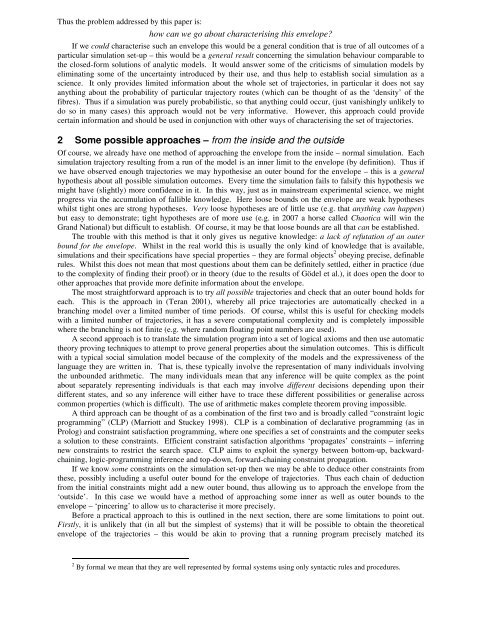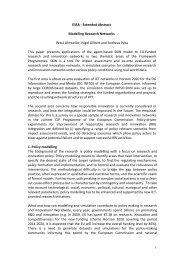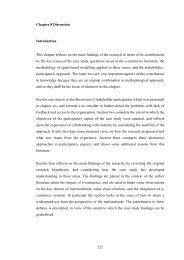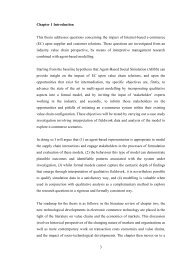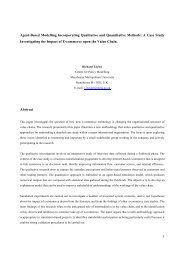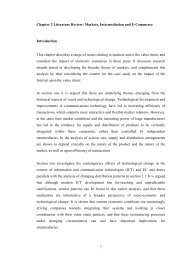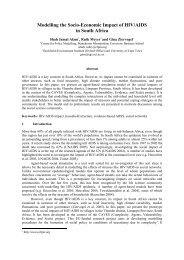characterising the envelope of sets of social simulation trajectories
characterising the envelope of sets of social simulation trajectories
characterising the envelope of sets of social simulation trajectories
Create successful ePaper yourself
Turn your PDF publications into a flip-book with our unique Google optimized e-Paper software.
Thus <strong>the</strong> problem addressed by this paper is:how can we go about <strong>characterising</strong> this <strong>envelope</strong>?If we could characterise such an <strong>envelope</strong> this would be a general condition that is true <strong>of</strong> all outcomes <strong>of</strong> aparticular <strong>simulation</strong> set-up – this would be a general result concerning <strong>the</strong> <strong>simulation</strong> behaviour comparable to<strong>the</strong> closed-form solutions <strong>of</strong> analytic models. It would answer some <strong>of</strong> <strong>the</strong> criticisms <strong>of</strong> <strong>simulation</strong> models byeliminating some <strong>of</strong> <strong>the</strong> uncertainty introduced by <strong>the</strong>ir use, and thus help to establish <strong>social</strong> <strong>simulation</strong> as ascience. It only provides limited information about <strong>the</strong> whole set <strong>of</strong> <strong>trajectories</strong>, in particular it does not sayanything about <strong>the</strong> probability <strong>of</strong> particular trajectory routes (which can be thought <strong>of</strong> as <strong>the</strong> ‘density’ <strong>of</strong> <strong>the</strong>fibres). Thus if a <strong>simulation</strong> was purely probabilistic, so that anything could occur, (just vanishingly unlikely todo so in many cases) this approach would not be very informative. However, this approach could providecertain information and should be used in conjunction with o<strong>the</strong>r ways <strong>of</strong> <strong>characterising</strong> <strong>the</strong> set <strong>of</strong> <strong>trajectories</strong>.2 Some possible approaches – from <strong>the</strong> inside and <strong>the</strong> outsideOf course, we already have one method <strong>of</strong> approaching <strong>the</strong> <strong>envelope</strong> from <strong>the</strong> inside – normal <strong>simulation</strong>. Each<strong>simulation</strong> trajectory resulting from a run <strong>of</strong> <strong>the</strong> model is an inner limit to <strong>the</strong> <strong>envelope</strong> (by definition). Thus ifwe have observed enough <strong>trajectories</strong> we may hypo<strong>the</strong>sise an outer bound for <strong>the</strong> <strong>envelope</strong> – this is a generalhypo<strong>the</strong>sis about all possible <strong>simulation</strong> outcomes. Every time <strong>the</strong> <strong>simulation</strong> fails to falsify this hypo<strong>the</strong>sis wemight have (slightly) more confidence in it. In this way, just as in mainstream experimental science, we mightprogress via <strong>the</strong> accumulation <strong>of</strong> fallible knowledge. Here loose bounds on <strong>the</strong> <strong>envelope</strong> are weak hypo<strong>the</strong>seswhilst tight ones are strong hypo<strong>the</strong>ses. Very loose hypo<strong>the</strong>ses are <strong>of</strong> little use (e.g. that anything can happen)but easy to demonstrate; tight hypo<strong>the</strong>ses are <strong>of</strong> more use (e.g. in 2007 a horse called Chaotica will win <strong>the</strong>Grand National) but difficult to establish. Of course, it may be that loose bounds are all that can be established.The trouble with this method is that it only gives us negative knowledge: a lack <strong>of</strong> refutation <strong>of</strong> an outerbound for <strong>the</strong> <strong>envelope</strong>. Whilst in <strong>the</strong> real world this is usually <strong>the</strong> only kind <strong>of</strong> knowledge that is available,<strong>simulation</strong>s and <strong>the</strong>ir specifications have special properties – <strong>the</strong>y are formal objects 2 obeying precise, definablerules. Whilst this does not mean that most questions about <strong>the</strong>m can be definitely settled, ei<strong>the</strong>r in practice (dueto <strong>the</strong> complexity <strong>of</strong> finding <strong>the</strong>ir pro<strong>of</strong>) or in <strong>the</strong>ory (due to <strong>the</strong> results <strong>of</strong> Gödel et al.), it does open <strong>the</strong> door too<strong>the</strong>r approaches that provide more definite information about <strong>the</strong> <strong>envelope</strong>.The most straightforward approach is to try all possible <strong>trajectories</strong> and check that an outer bound holds foreach. This is <strong>the</strong> approach in (Teran 2001), whereby all price <strong>trajectories</strong> are automatically checked in abranching model over a limited number <strong>of</strong> time periods. Of course, whilst this is useful for checking modelswith a limited number <strong>of</strong> <strong>trajectories</strong>, it has a severe computational complexity and is completely impossiblewhere <strong>the</strong> branching is not finite (e.g. where random floating point numbers are used).A second approach is to translate <strong>the</strong> <strong>simulation</strong> program into a set <strong>of</strong> logical axioms and <strong>the</strong>n use automatic<strong>the</strong>ory proving techniques to attempt to prove general properties about <strong>the</strong> <strong>simulation</strong> outcomes. This is difficultwith a typical <strong>social</strong> <strong>simulation</strong> model because <strong>of</strong> <strong>the</strong> complexity <strong>of</strong> <strong>the</strong> models and <strong>the</strong> expressiveness <strong>of</strong> <strong>the</strong>language <strong>the</strong>y are written in. That is, <strong>the</strong>se typically involve <strong>the</strong> representation <strong>of</strong> many individuals involving<strong>the</strong> unbounded arithmetic. The many individuals mean that any inference will be quite complex as <strong>the</strong> pointabout separately representing individuals is that each may involve different decisions depending upon <strong>the</strong>irdifferent states, and so any inference will ei<strong>the</strong>r have to trace <strong>the</strong>se different possibilities or generalise acrosscommon properties (which is difficult). The use <strong>of</strong> arithmetic makes complete <strong>the</strong>orem proving impossible.A third approach can be thought <strong>of</strong> as a combination <strong>of</strong> <strong>the</strong> first two and is broadly called “constraint logicprogramming” (CLP) (Marriott and Stuckey 1998). CLP is a combination <strong>of</strong> declarative programming (as inProlog) and constraint satisfaction programming, where one specifies a set <strong>of</strong> constraints and <strong>the</strong> computer seeksa solution to <strong>the</strong>se constraints. Efficient constraint satisfaction algorithms ‘propagates’ constraints – inferringnew constraints to restrict <strong>the</strong> search space. CLP aims to exploit <strong>the</strong> synergy between bottom-up, backwardchaining,logic-programming inference and top-down, forward-chaining constraint propagation.If we know some constraints on <strong>the</strong> <strong>simulation</strong> set-up <strong>the</strong>n we may be able to deduce o<strong>the</strong>r constraints from<strong>the</strong>se, possibly including a useful outer bound for <strong>the</strong> <strong>envelope</strong> <strong>of</strong> <strong>trajectories</strong>. Thus each chain <strong>of</strong> deductionfrom <strong>the</strong> initial constraints might add a new outer bound, thus allowing us to approach <strong>the</strong> <strong>envelope</strong> from <strong>the</strong>‘outside’. In this case we would have a method <strong>of</strong> approaching some inner as well as outer bounds to <strong>the</strong><strong>envelope</strong> – ‘pincering’ to allow us to characterise it more precisely.Before a practical approach to this is outlined in <strong>the</strong> next section, <strong>the</strong>re are some limitations to point out.Firstly, it is unlikely that (in all but <strong>the</strong> simplest <strong>of</strong> systems) that it will be possible to obtain <strong>the</strong> <strong>the</strong>oretical<strong>envelope</strong> <strong>of</strong> <strong>the</strong> <strong>trajectories</strong> – this would be akin to proving that a running program precisely matched its2 By formal we mean that <strong>the</strong>y are well represented by formal systems using only syntactic rules and procedures.


